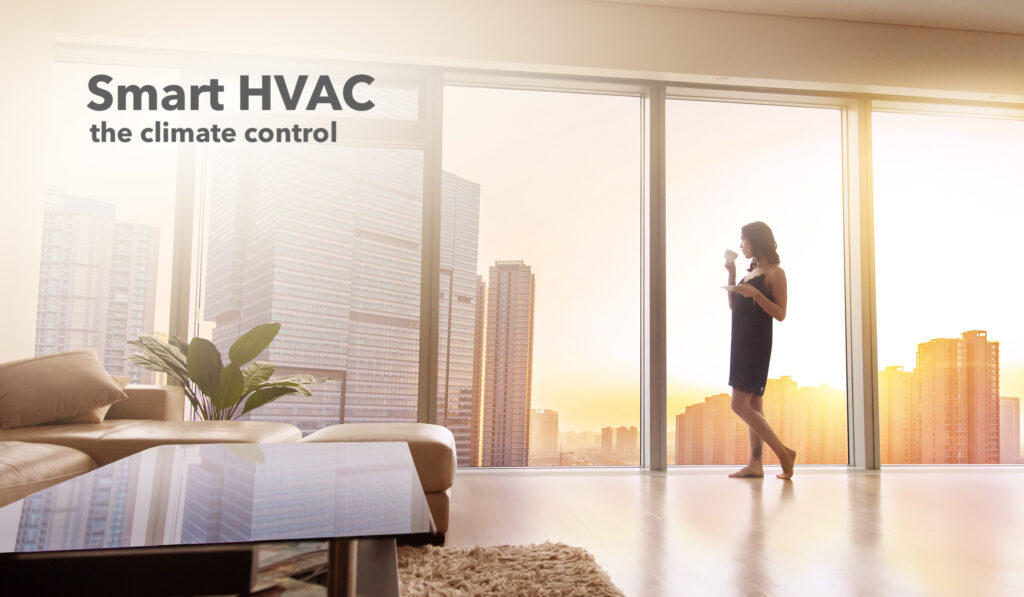
The Dawn of Smart Climate Control
Imagine a world where your home anticipates your comfort needs, adjusting the temperature and humidity before you even realize you’re feeling a bit too warm or chilly. This isn’t a futuristic fantasy; it’s the reality offered by smart climate control systems. These systems are rapidly transforming how we interact with our living spaces, offering unprecedented levels of convenience, energy efficiency, and personalized comfort.
At its core, smart climate control involves using technology to automate and optimize the heating, ventilation, and air conditioning (HVAC) systems in your home or office. This goes beyond traditional thermostats that simply maintain a set temperature. Smart systems learn your preferences, monitor environmental conditions, and adapt in real-time to ensure optimal comfort and energy savings. The integration of sensors, sophisticated algorithms, and connectivity makes these systems truly intelligent.
The appeal of smart climate control is multifaceted. For homeowners, it translates to lower energy bills, a more comfortable living environment, and increased convenience. For businesses, it represents an opportunity to reduce operational costs, improve employee productivity, and enhance their sustainability efforts. As concerns about climate change and energy consumption continue to grow, smart climate control is poised to play an increasingly vital role in creating a more sustainable future.
Why Choose Smart Climate Control? Unveiling the Benefits
The advantages of implementing a smart climate control system are extensive and far-reaching. Here’s a detailed look at some of the key benefits:
1. Energy Efficiency and Cost Savings
This is perhaps the most compelling reason for adopting smart climate control. Traditional HVAC systems often operate inefficiently, wasting energy by heating or cooling unoccupied rooms or running at full capacity when only a fraction of that power is needed. Smart systems, on the other hand, use a variety of techniques to minimize energy consumption:
- Learning Your Habits: Smart thermostats learn your daily routines and automatically adjust the temperature accordingly. For example, they can lower the temperature when you’re away at work and raise it again shortly before you return home.
- Zone Control: Many smart systems allow you to control the temperature in individual zones or rooms. This means you can heat or cool only the areas you’re using, rather than the entire house.
- Weather Monitoring: Smart systems can monitor local weather conditions and adjust the HVAC system proactively. For example, they can reduce cooling output on a cloudy day or pre-heat the house before a cold snap.
- Adaptive Algorithms: Sophisticated algorithms analyze your energy usage patterns and identify opportunities for further optimization. They can fine-tune the system’s settings over time to maximize efficiency.
These features can lead to significant energy savings, often ranging from 10% to 30% or even more, depending on your climate and usage patterns. Over time, these savings can easily offset the initial cost of the smart climate control system.
2. Enhanced Comfort and Convenience
Beyond energy efficiency, smart climate control offers a level of comfort and convenience that traditional systems simply can’t match:
- Personalized Comfort: Smart systems allow you to create personalized comfort profiles for different users and situations. For example, you can set a different temperature for your bedroom than for your living room, or create a “sleep” profile that automatically lowers the temperature at night.
- Remote Control: You can control your smart climate control system from anywhere in the world using your smartphone or tablet. This is especially useful if you’re traveling or want to adjust the temperature before you arrive home.
- Voice Control: Many smart systems are compatible with voice assistants like Amazon Alexa or Google Assistant. This allows you to adjust the temperature using simple voice commands.
- Automated Scheduling: You can create detailed schedules that automatically adjust the temperature throughout the day, based on your preferences and activities.
These features make it incredibly easy to maintain a comfortable living environment, without having to constantly adjust the thermostat manually.
3. Improved Air Quality
Smart climate control systems can also help improve the air quality in your home:
- Air Filter Monitoring: Some systems can monitor the condition of your air filters and alert you when they need to be replaced. This helps ensure that your HVAC system is operating efficiently and that the air you’re breathing is clean and healthy.
- Ventilation Control: Smart systems can automatically adjust ventilation rates based on occupancy and air quality conditions. This helps to remove pollutants and allergens from the air.
- Humidity Control: Maintaining optimal humidity levels is crucial for both comfort and health. Smart systems can monitor and adjust humidity levels to prevent mold growth and other problems.
By improving air quality, smart climate control can help reduce allergy symptoms, improve respiratory health, and create a healthier living environment overall.
4. Increased Home Value
Installing a smart climate control system can also increase the value of your home. As smart home technology becomes increasingly popular, buyers are willing to pay a premium for homes that are equipped with these features. A smart climate control system is a valuable asset that can make your home more attractive to potential buyers.
5. Sustainability and Environmental Responsibility
By reducing energy consumption, smart climate control contributes to a more sustainable future. Lower energy usage translates to reduced greenhouse gas emissions and a smaller carbon footprint. Choosing a smart climate control system is a responsible decision that can help protect the environment for future generations.
Components of a Smart Climate Control System
A smart climate control system typically consists of several key components working together seamlessly:
1. Smart Thermostats
The heart of any smart climate control system is the smart thermostat. These thermostats are much more advanced than traditional models, offering features like:
- Wi-Fi Connectivity: Allows you to control the thermostat remotely using your smartphone or tablet.
- Learning Capabilities: Learns your habits and preferences to automatically adjust the temperature.
- Zone Control: Allows you to control the temperature in individual zones or rooms.
- Touchscreen Displays: Provides a user-friendly interface for adjusting settings and viewing information.
- Integration with Other Smart Home Devices: Can be integrated with other smart home devices, such as lighting systems and security systems.
Popular smart thermostat brands include Nest, Ecobee, Honeywell, and Sensibo. Each brand offers a range of models with different features and price points, so it’s important to compare your options carefully.
2. Smart Sensors
Smart sensors play a crucial role in monitoring environmental conditions and providing data to the smart thermostat. These sensors can measure:
- Temperature: Provides accurate temperature readings for different rooms or zones.
- Humidity: Monitors humidity levels to prevent mold growth and improve comfort.
- Occupancy: Detects whether a room is occupied, allowing the system to adjust the temperature accordingly.
- Air Quality: Measures air quality parameters like particulate matter and volatile organic compounds (VOCs).
The data from these sensors is used to optimize the performance of the HVAC system and ensure that the living environment is comfortable and healthy.
3. Smart HVAC Systems
While a smart thermostat can be used with most existing HVAC systems, upgrading to a smart HVAC system can further enhance efficiency and performance. These systems offer features like:
- Variable-Speed Motors: Allows the system to adjust its output based on demand, rather than running at full speed all the time.
- Zoned Heating and Cooling: Enables precise temperature control in individual zones or rooms.
- Smart Diagnostics: Monitors the system’s performance and alerts you to potential problems.
- Integration with Smart Home Platforms: Can be seamlessly integrated with other smart home devices and platforms.
Smart HVAC systems are more expensive than traditional systems, but they can offer significant energy savings and improved comfort over the long term.
4. Mobile Apps and Cloud Connectivity
A key component of any smart climate control system is the mobile app and cloud connectivity. These features allow you to:
- Control the system remotely: Adjust the temperature, set schedules, and monitor energy usage from anywhere in the world.
- Receive alerts and notifications: Get notified of potential problems, such as a malfunctioning HVAC system or a sudden temperature change.
- Access historical data: View historical data on energy usage and temperature patterns.
- Integrate with other smart home devices: Connect the system to other smart home devices and platforms.
The mobile app and cloud connectivity provide a user-friendly interface for managing your smart climate control system and accessing valuable information.
Implementing Smart Climate Control: A Step-by-Step Guide
Implementing a smart climate control system can seem daunting, but it’s actually a relatively straightforward process. Here’s a step-by-step guide to help you get started:
1. Assess Your Needs and Goals
Before you start shopping for smart climate control products, it’s important to assess your needs and goals. Ask yourself the following questions:
- What are your primary goals? Are you primarily interested in saving energy, improving comfort, or enhancing air quality?
- What is your budget? Smart climate control systems can range in price from a few hundred dollars to several thousand dollars.
- What type of HVAC system do you have? Is it compatible with smart thermostats and other smart climate control products?
- How many zones do you need to control? Do you want to control the temperature in individual rooms or just in a few key areas?
Answering these questions will help you narrow down your options and choose the right products for your needs.
2. Choose the Right Products
Once you’ve assessed your needs and goals, it’s time to start shopping for smart climate control products. Consider the following factors when making your decision:
- Compatibility: Make sure the products you choose are compatible with your existing HVAC system and other smart home devices.
- Features: Choose products with the features that are most important to you, such as zone control, learning capabilities, and voice control.
- Ease of Use: Look for products that are easy to install and use.
- Reviews: Read online reviews to get an idea of the product’s performance and reliability.
- Price: Compare prices from different retailers to find the best deal.
Don’t be afraid to mix and match products from different brands to create a system that meets your specific needs.
3. Installation
The installation process will vary depending on the specific products you choose. However, here are some general tips:
- Read the instructions carefully: Before you start, read the installation instructions carefully.
- Turn off the power: Before working on any electrical components, turn off the power to your HVAC system at the circuit breaker.
- Follow the wiring diagrams: Pay close attention to the wiring diagrams when connecting the smart thermostat to your HVAC system.
- Test the system: After you’ve installed the products, test the system to make sure it’s working properly.
If you’re not comfortable installing the products yourself, you can hire a professional HVAC technician to do it for you.
4. Configuration and Customization
Once the system is installed, you’ll need to configure it and customize it to your preferences. This typically involves:
- Connecting the system to your Wi-Fi network: This allows you to control the system remotely using your smartphone or tablet.
- Setting up user profiles: Create personalized comfort profiles for different users and situations.
- Creating schedules: Set up automated schedules that adjust the temperature throughout the day.
- Integrating with other smart home devices: Connect the system to other smart home devices, such as lighting systems and security systems.
Take the time to experiment with different settings and features to find what works best for you.
5. Monitoring and Optimization
After the system is configured, it’s important to monitor its performance and make adjustments as needed. This involves:
- Tracking energy usage: Monitor your energy usage to see how much you’re saving.
- Adjusting settings: Fine-tune the system’s settings over time to maximize efficiency and comfort.
- Keeping the system up-to-date: Install software updates to ensure that the system is running smoothly and efficiently.
By monitoring and optimizing your smart climate control system, you can ensure that it’s providing the best possible performance for years to come.
Choosing the Right Smart Climate Control System: Key Considerations
Selecting the ideal smart climate control system requires careful consideration of several factors. Here’s a breakdown of the key aspects to evaluate:
1. Compatibility with Existing HVAC Systems
Before diving into the world of smart thermostats and sensors, ensure compatibility with your current HVAC setup. Not all systems are universally compatible. Check the manufacturer’s specifications to confirm that the smart devices you’re considering will work seamlessly with your furnace, air conditioner, or heat pump. Some older systems may require adapters or professional installation to ensure proper integration.
2. Zone Control Capabilities
Zone control allows you to regulate the temperature in different areas of your home independently. This is particularly beneficial for larger homes or those with varying occupancy patterns. Consider whether you need individual room control or if zoning by floor is sufficient. Systems with multiple sensor support and zoning capabilities offer greater flexibility and energy savings.
3. Learning and Automation Features
The intelligence of a smart climate control system lies in its ability to learn your preferences and automate adjustments. Look for systems that offer learning algorithms that adapt to your schedule and habits. Features like geofencing, which adjusts the temperature based on your location, can further enhance automation and energy efficiency.
4. Ease of Installation and Use
While some smart climate control systems are designed for DIY installation, others may require professional assistance. Consider your technical skills and comfort level when choosing a system. Opt for systems with clear installation instructions and user-friendly interfaces. A well-designed mobile app is essential for remote control and monitoring.
5. Integration with Smart Home Ecosystems
If you already have a smart home ecosystem, such as Amazon Alexa, Google Assistant, or Apple HomeKit, ensure that the smart climate control system you choose is compatible. Seamless integration allows you to control your HVAC system using voice commands and automate tasks across different devices.
6. Security and Privacy Considerations
Smart climate control systems collect data about your usage patterns and preferences. Consider the security and privacy implications of sharing this data with the manufacturer. Choose systems from reputable brands with strong security measures and transparent privacy policies. Look for features like two-factor authentication and data encryption.
7. Cost and Long-Term Savings
The initial cost of a smart climate control system can vary significantly depending on the features and brand. Consider the long-term savings in energy bills when evaluating the cost-effectiveness of different systems. Factor in potential rebates or incentives offered by your utility company or government agencies.
The Future of Smart Climate Control
The field of smart climate control is constantly evolving, with new technologies and innovations emerging all the time. Here are some of the trends that are shaping the future of this exciting area:
1. Artificial Intelligence and Machine Learning
AI and machine learning are playing an increasingly important role in smart climate control. These technologies are being used to:
- Predict energy usage: AI algorithms can analyze historical data to predict future energy usage and optimize the system’s settings accordingly.
- Detect anomalies: Machine learning models can detect anomalies in the system’s performance, such as a malfunctioning HVAC system or a sudden temperature change.
- Personalize comfort: AI can be used to create highly personalized comfort profiles based on individual preferences and physiological data.
As AI and machine learning become more sophisticated, they will enable even greater levels of energy efficiency and personalized comfort.
2. Integration with Renewable Energy Sources
Smart climate control systems are increasingly being integrated with renewable energy sources, such as solar panels and wind turbines. This allows homeowners to reduce their reliance on fossil fuels and lower their carbon footprint. Smart systems can automatically adjust energy usage based on the availability of renewable energy, maximizing self-consumption and minimizing reliance on the grid.
3. Demand Response Programs
Demand response programs are initiatives that encourage consumers to reduce their energy consumption during peak demand periods. Smart climate control systems can be integrated with demand response programs, allowing homeowners to earn incentives for reducing their energy usage during these times. This helps to reduce strain on the grid and prevent blackouts.
4. Predictive Maintenance
Smart climate control systems can use sensors and algorithms to predict when HVAC equipment is likely to fail. This allows homeowners to schedule maintenance proactively, preventing costly repairs and extending the lifespan of their equipment. Predictive maintenance can also improve the efficiency of the HVAC system, reducing energy consumption and lowering operating costs.
5. Enhanced Air Quality Monitoring
Future smart climate control systems will likely include more sophisticated air quality monitoring capabilities. These systems will be able to detect a wider range of pollutants and allergens, providing homeowners with detailed information about the air they’re breathing. This information can be used to adjust ventilation rates, filter the air, and take other steps to improve air quality.
Conclusion: Embracing a Smarter, More Comfortable Future
Implementing smart climate control is more than just upgrading your thermostat; it’s about embracing a smarter, more comfortable, and sustainable future. The benefits are undeniable, ranging from significant energy savings and enhanced comfort to improved air quality and increased home value. As technology continues to advance, smart climate control systems will become even more sophisticated and integrated into our lives.
By taking the time to assess your needs, choose the right products, and configure the system properly, you can unlock the full potential of smart climate control and create a living environment that is both comfortable and energy-efficient. Embrace the future of climate control and experience the difference that smart technology can make in your home and in the world.

